The Golf Courses of Cheshire and their Architects
by Mark Rowlinson
The welcome news that the Open Championship is to return to Hoylake will, I have no doubt, bring new golfing visitors to this part of England, curious to find out for themselves just what lies in store for the world’s greatest players in 2006. With Royal Birkdale, Royal Lytham, Formby, Hillside and other top-flight courses only a few miles away up the Lancashire coast many visitors will, naturally, head in that direction, nor should the excellent-value and good-looking courses of North Wales be ignored. But Cheshire has many fascinating courses worthy of a visit by those with an eye for golf architecture. In 1993, in the course of researching for a golf book (long out of print), I had the good fortune to play all 83 courses then extant in the county. Happily, all the clubs noted here welcome green-fee paying guests.
Royal Liverpool at Hoylake is the senior Cheshire course in every way and the only one ever to get into those lists of Top 100s so popular with the golfing press. Until recent years it possessed three of the most uncompromising holes in championship golf. The only survivor of them is the 1st, a bunkerless dog-leg with out-of-bounds on both sides, a terrifying drive into a stiff wind. The 7th was capricious, to say the least, with out-of-bounds just off the putting surface on the left and many an apparently perfectly-struck ball bouncing over the Kop to ruin the scorecard. More recently the green was flattened at the front and the back enlarged to accept a higher proportion of decently-struck tee shots. The out-of-bounds has been removed and bunkers and moundwork inserted while between tee and green a boggy area has been opened up, turning it into a minor marsh. The real casualty has been the 17th which used to feature a green so hard up against the fence that it was not unknown for golfers to putt out-of-bounds. It was as notorious a 17th as the Road Hole at St Andrews. The architect, Donald Steel, in preparing the course for future Opens, has created a new green 40 yards further on and 20 yards to the left. His other alterations have been less drastic, mostly to facilitate safety and spectator movement. The 3rd hole has been moved forward, entailing the construction of a new green and there is a new green at the last, angled to the left. He has also revised the shaping and bunkering of a number of holes.
Just over the road from Royal Liverpool is Hoylake Municipal, a James Braid layout from the 1930s. The site is pretty flat but Braid employed the traditional seaside defences of pot bunkers as well as utilising ditches and ponds. Braid also laid out the courses at Disley, high in the hills to the east of the county, Helsby, Warrington and Leigh (which is more properly a Lancashire club). Perhaps his best work in Cheshire is at Mere, an opulent country club just outside Knutsford. The first three or four holes are attractive, but to my taste the holes around the turn are less interesting and Braid’s intended strategies for several of these holes have been altered. However, the course picks up again on the long par-4 13th and the finish from there is first rate, handsome and challenging for golfers of all ability.
Another of Hoylake’s near neighbours is Wallasey, first laid out by Old Tom Morris. How much of his work has survived I cannot say – some was lost to coastal erosion – but today’s course is a beauty of a links with towering sand dunes and lots of movement in the ground. It was at Wallasey that Bobby Jones had to qualify for the 1930 Open Championship (part of his remarkable ‘impregnable quadrilateral’). Wallasey was also the home club of Dr. Stableford who gave his name to that very successful form of point scoring so beloved of golf societies in Britain. The opening holes amidst the dunes are first rate and the coastal views from the 4th tee are unrivalled. The finish is brilliant with a fine, long par 3 with a formidable carry to a plateau green at the 16th. A very full-length par 4 follows, its green sheltered in a fold of the dunes, while the 18th bounds gloriously downhill over a crumpled fairway towards a well-defended green.
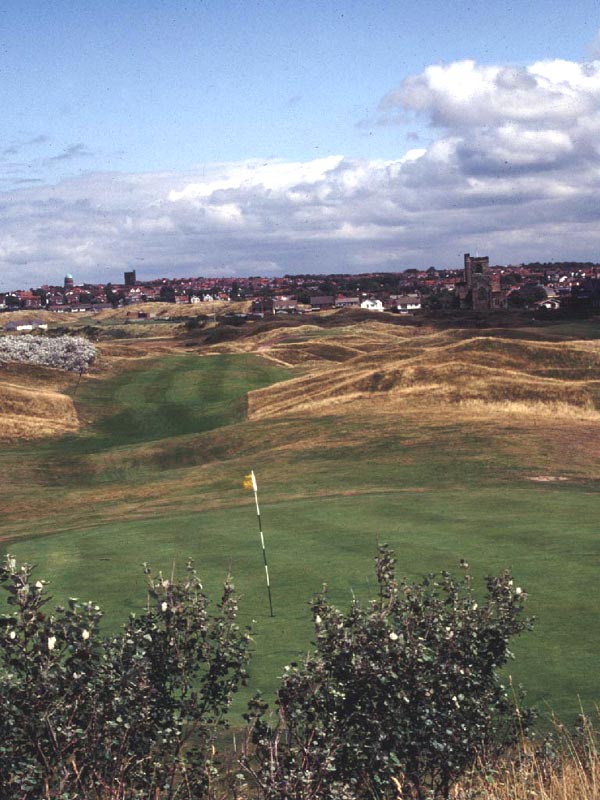
The 3rd at Wallasey set amongst some mighty dunes.
Morris’s brother, Jack, was professional at Hoylake and he is credited with the design of the first holes at Caldy a few miles away. It has been much altered over the years, most recently by Donald Steel, and is a fine mixture of parkland, downland and genuine links holes overlooking the Dee Estuary and the hills of Denbigh and Flint. The links holes, from the 3rd to the 10th, are most attractive and the 6th, with a pitch over a ditch to a green perched right on the water’s edge is probably the pick of those holes. At about 390 yards the 3rd may not seem driveable but its dog-leg is sufficiently sharp that big hitters can cut the corner and shoot for the green. However, if they fall short they will almost certainly end up in a pond. There is another lovely course further up the Dee Estuary at Heswall but I am not aware of who the architects might have been.
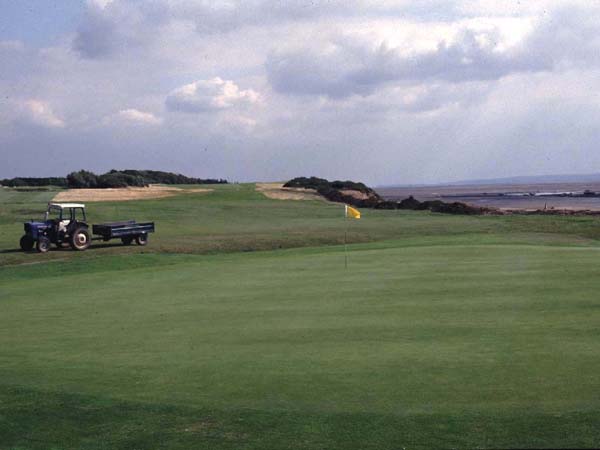
The 6th at Caldy
Staying on the Wirral, that spit of Cheshire isolated between the Mersey and Dee Estuaries (although nowadays administratively part of the pseudo-county of Merseyside), there is an excellent little course in Birkenhead, Wirral Ladies’, one of three ladies’ clubs in the UK, the others being at Formby and Sunningdale. Harold Hilton, the great Hoylake Amateur and Open Champion, advised on the first 9-hole course here but little, if any, of his work survives. Today’s course was laid out after the Second World War but it is very traditional in design with small greens cunningly raised up to deflect the wavering approach shot. It may be short on paper but it is long on quality. The rough is serious, the bunkering sparing but judicious and the condition exemplary. Male visitors are welcomed and their game will be seriously examined.
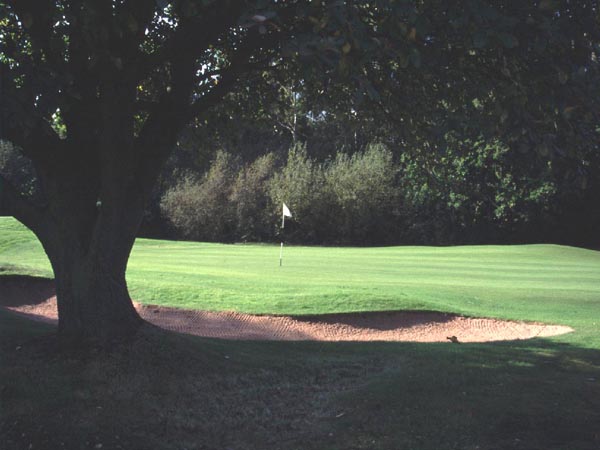
The 6th at Wirral Ladies’
Also near Birkenhead is Prenton, a pleasant parkland course with some surviving work by Alister Mackenzie. The opening holes taking play to the far end of the course are, for my money, the most interesting, the 4th being a par 4 of around 370 yards made particularly hazardous by the ditch which crosses the fairway at 255 yards out, just where the hole swings sharply left towards the green. You cross the remains of a Roman Road here, too. The 5th green is set down in an amphitheatre (it was once a pond) and is quite an unusual hole.
The Wirral need not detain us longer, so, staying with Alister Mackenzie, it is worth noting, merely for the record, that a little of his work survives at Didsbury. The course suffered major disruption when the M60 motorway was constructed right through the middle of it. The necessary amendments were carried out by Peter Alliss and Dave Thomas. A road was planned also to ruin the good Doctor’s work at Hazel Grove and the club took the opportunity to call in Tom Macauley, the Irish architect who was one of the first in Britain to design with the aid of a computer. As far as I know the construction of this road has been abandoned, so perhaps this work need never have taken place. I have to say that, on the experience of a single visit only, shortly after the reopening of the course, Macauley’s holes and Mackenzie’s are very different in style. The course is divided by a railway line and the holes nearer the clubhouse, Macauley’s, are modern in feel, strategy and look. Macauley has also given us a good technical test at Birchwood near Warrington. It is a very worthwhile use of some uninteresting ground between a motorway, a factory estate and housing developments. Much use is made of water and its environmental impact in this otherwise unprepossessing spot is considerable.
There is, however, one outstanding Mackenzie course, Reddish Vale. It is located in a rather impoverished suburb of Stockport and suffers occasionally from vandalism but Mackenzie’s striking design holds up pretty well under the circumstances. The course starts out over bumpy, high ground, quite constricted but using the lie of the land cunningly. Then the 6th, a par 3 of about 240 yards, plunges steeply downhill to a green set in a bend of the River Tame with half a dozen attendant bunkers. It can be wicked. There are five short holes in all and perhaps only the 12th is comparatively uninteresting. The diminutive 9th is a cracker, under 140 yards but played steeply uphill to a green beyond bunkers. Surely originally a bogey 5, the 13th is a brute of a long par 4 with the approach played blind over a ridge to a minuscule, sloping green perched above a drop into a pit. Played to a green with water on three sides, the 16th is notably attractive. I believe the original 17th was abandoned and the present hole is rather unsatisfactory. As Mackenzie built it, the 18th was a slog of a hill-climb with the fairway rising in a series of terraces. It is still a slog of a hill-climb but the terraces have been removed to make it a more constant affair. These criticisms notwithstanding, real character simply oozes from this fascinating course.
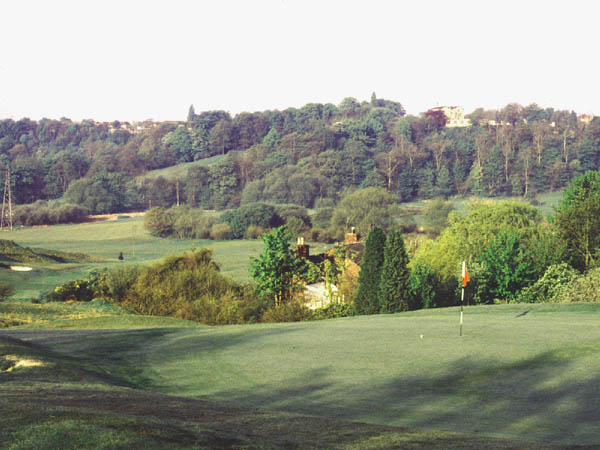
The 9th at Reddish Vale
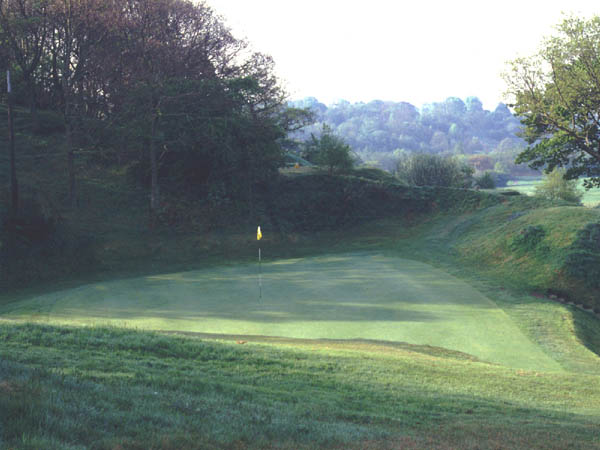
The unique 13th green complex at Reddish Vale with the mound that must be cleared.
Cheshire is full of clubs founded in the 19th century with Cheadle (1885) being the oldest survivor after Royal Liverpool. It is a little 9-hole course, only 5006 yards from the very back, designed by one R. Renouf who I take to be a member of the Jersey Renoufs. They were part of that remarkably gifted group of golfers who dominated the game at the close of the 19th century. In the field for the 1899 Open Championship there were no fewer than seven Jersey players, three Vardons, Ted Ray, two Gaudins, and a Renouf. T.G. (Tommy) Renouf became professional at the prestigious Manchester Golf Club, ending his days at Stockport. Amazingly, he spoke little or no English when he arrived on the mainland. He could not match Harry Vardon’s distinguished playing record, though he played at a high enough level to have beaten Walter Hagen, then in his prime, in matchplay. Renouf had a good reputation as a teacher and apparently attracted Fred Astaire and his sister Adele to the Manchester Club for lessons. He is credited with designing the 9-hole course at Alderley Edge which opens with three excellent two-shot holes and features a sterling do-or-die par-3 8th, all carry across a chasm to a domed, hilltop green. Unfortunately the course loses its poise in the middle, the 6th being a ghastly short hole on which luck plays far too important a part.
That other fine Jersey player, big-hitting Ted Ray, made a fine job of the design of Sandiway, which he laid out in 1921, the year after his US Open triumph at the Inverness Club. Harry Colt improved the layout later and three new holes had to be constructed when the main Chester road was widened. At 6435 yards Sandiway’s statistics may look unimpressive but par is only 70 and there are plenty of big holes. On the back nine the 10th, 12th and 14th are all in excess of 440 yards and play uphill. All three call for very precisely placed drives as well as length to give any hope of reaching the green in two. The hills are not severe but they have been utilised well to give each hole its strategy and character. The 17th is one of those delicious rarities, a 305-yard par 4 that manages to challenge golfers of all abilities, necessitating a good thump from the tee to make it to the far side of a deep valley, and the shot must be accurate, too, with a tree in the fairway a little short of the green complicating matters. Surrounding the green are many deep bunkers so, while pars and birdies are not uncommon, neither are sixes and sevens or even worse.
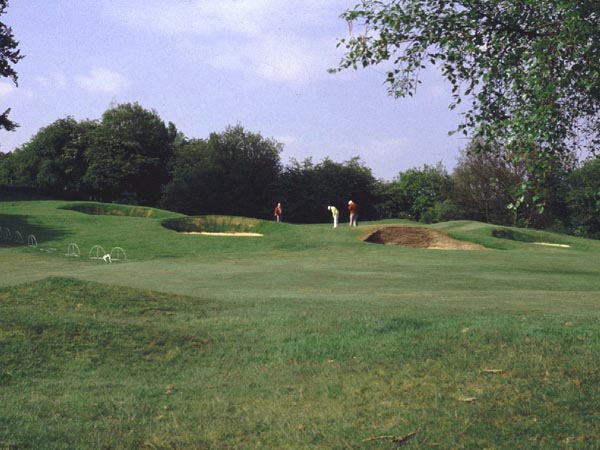
The 17th at Sandiway
It is a matter of pleasant debate whether Sandiway or Delamere Forest is the better course in this part of Mid-Cheshire. Both enjoy delightfully secluded locations, have the benefit of beautifully rolling sites and are fine examples of strategic design. Delamere Forest is one of Herbert Fowler’s creations. Fowler’s masterpieces are the East Course at Saunton and both courses at the Berkshire, but I should have no hesitation in recommending the others of his courses that I know well: Beau Desert, Bull Bay, Huddersfield (if rather hilly in parts) and, of course, Delamere Forest. Six of the first eight holes are par 4s measuring over 410 yards so stout hitting is the order of the day. For that matter, so is shot placement, the contours of the land being employed cunningly to punish the unintelligent shot. The 8th is magical, demanding a big and perfectly lined shot to carry across a valley and a prominent bunker the better to set up the approach to the green which is perched on a ledge above an abyss. There is a seemingly easier route out to the right, but subsequent shots are then thwarted by plentiful bunkers and high ground.
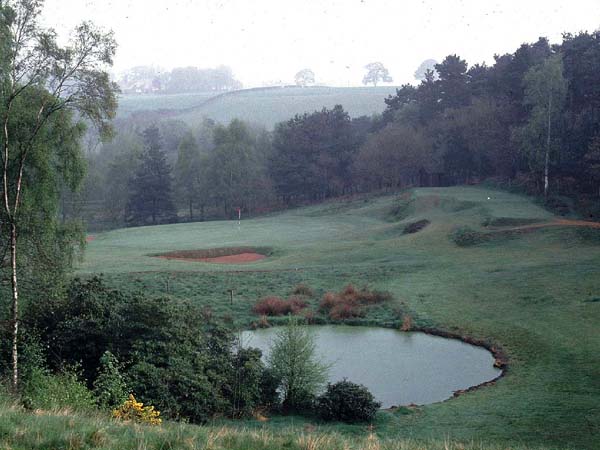
The 14th at Delamere Forest
Of Cheshire’s other old courses, Stockport is worth a mention. It was laid out in 1908 by the club’s professional Peter Barrie advised by Sandy Herd, the golfer who finished off the gutta percha ball for good by demolishing a classy field in the 1902 Open Championship using the new Haskell ball. James Braid made a few alterations in 1935 and Martin Hawtree amended the bunkering recently. It is not a long course, with only two par 4s exceeding 400 yards, but for the average player it is a very satisfying course to play with a well balanced collection of challenges.
Sandy Herd is also one of a number of designers who have worked on the Wilmslow course since it moved to its present site in 1903. James Braid, Tom Simpson, George Duncan, Fred Hawtree, Cotton, Penninck, Lawrie, Dave Thomas and Donald Steel have all left their mark here. Up until the mid-1980s this was a regular stop on the European Tour (Greater Manchester Open and Martini International). It would be too short for today’s mighty hitters but it still gives the handicap-player an enjoyable round with a great deal of variety to the holes. Strategically, the toughest holes are the 2nd and 15th, both longish par 4s on which the correct line from the tee is absolutely essential. Most of the greens feature narrow entrances between bunkers and the course has reasonably withstood the onslaughts of fine players, professional and amateur, who have come here for Regional Qualifying for the Open Championship in recent years. Course maintenance is exemplary and winter golf here is unusually pleasurable.
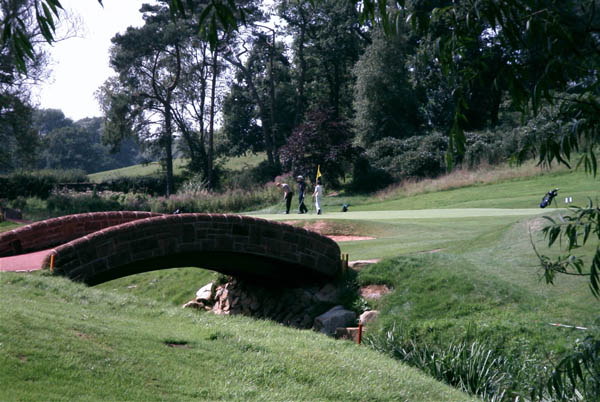
The 9th at Wilmslow
For such a prolific designer, Harry Colt does not seem to have done much design work in Cheshire. His one contribution, however, is a beauty, Prestbury. He had the advantage of working on a fecund rolling site, hilly but not to excess. It provided him with any number of excellent spots for greens and tees and, with so many greens raised up cunningly, Prestbury is a fine test of approach work. These greens did not happen overnight. At first all he did was level off a putting surface, sowing seed on whatever subsoil he uncovered. It was five years later that he returned to construct the greens we know today. On such a site bunkering need only be sparing and, indeed, what is probably the finest hole, the 16th, is bunkerless. The fairway climbs and curls left and it is imperative that the drive finishes in a good position, for the shot to the green must be shaped to land well to the right of the putting surface if it is to roll to the centre.
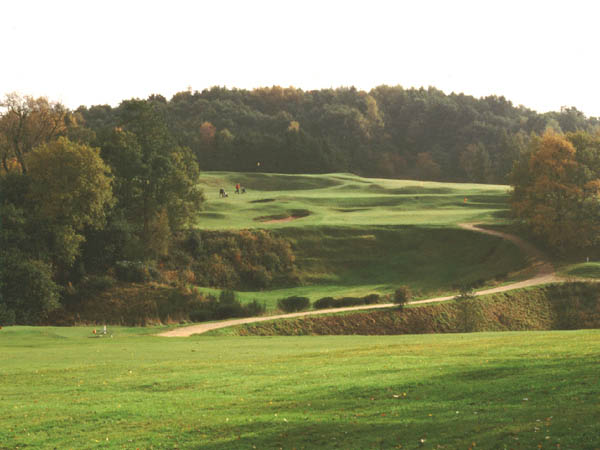
The appealing landscape at Prestbury
Before leaving the old courses I should record the handsome 10-hole course at Knutsford. It was laid out in beautiful parkland on the edge of the Tatton Hall estate by two talented and visionary amateurs by the name of Speakman and Taylor. The glorious setting helps but they clearly knew how to make the most of it.
Many new courses have sprung up in Cheshire over the last 15 years. Even the great Jack Nicklaus has been here, to lay out a course at Carden Park with his son, Steve. I have to say that, thoroughly strategic though the design is, it looks, for the most part, bland. There are good holes, such as the 7th and 15th, which offer alternative routes from tee to green depending on the skill level and confidence of the player and there are the almost obligatory lake holes, the 6th and 17th in particular. However most of the course occupies flattish meadowland and Nicklaus was at pains to preserve the pastoral landscape and conserve the indigenous flora and fauna. The more interesting land is on the higher ground behind the hotel and clubhouse where a course had been built a few years earlier. A local architect, Alan Higgins, laid that out. There are some very scenic holes on top of a rocky cliff amidst the pines and there are even holes laid out beside a vineyard (yes, even this far north) but it is an uneven course with a few dull holes to offset the handsome ones.
Dave Thomas is a leading architect in Europe these days and I should venture that his best work in Cheshire is the back nine at Mottram Hall Hotel. This part of the course rises and falls giving fine views to the hills of the Peak District and Thomas has utilised the contours to great effect, creating two of the most interesting par 4s in this part of the country, the 13th and 17th. The 13th fairway climbs and twists calling for extreme accuracy as well as considerable length on the drive and the green is set even further up behind a pair of bunkers. Again accuracy is essential from the 17th tee, but this time the drive must be controlled for length with a gully interrupting the fairway, and a bunker, a pond and out-of-bounds all within driving reach. Once more the long approach shot is played uphill to a well-sited green on high ground above bunkers. There is plenty of golfing challenge on the front nine, but the ground is much flatter and less intersting.
Donald Steel has won several design contracts in Cheshire. My favourite was the original Portal course outside Tarporley. As it was first built it had just eighteen holes, three of them on the far side of a lane on what was, long, long ago, a battlefield. This was such a spacious layout that it would have been quite impossible for a ball to be hit onto a neighbouring fairway. Unfortunately – to my mind – it was decided to add nine holes to make twenty-seven in all, reconfiguring the layout so that the main course was all on one site. Now it feels to me more cramped in places. Happily the best holes remain and the par-4 17th is a terrific hole and visitors will be amused to find a couple of bunkers, on what is now, I think, the 11th, made in the shape of dinosaur footprints. It seems that prehistoric pterodactyl bones had been unearthed there during course construction.
Simon Gidman, John Day and others have designed recent Cheshire courses of which, as yet, I have no experience, so I give the last word to the Hawtree dynasty whose masterpiece at Royal Birkdale is only a short drive away. Most of their Cheshire work has been in renovation and rebuilding. Like most British architects they have to be able to work with limited resources in little space and they have coaxed quarts out of pint pots at Eastham Lodge and Macclesfield, and it is perhaps their tiniest project which demonstrates this talent most abundantly, the little par-3 pitch-and-putt course at Adlington. No hole is as long as 90 yards yet the cleverly raised greens are elusive targets even for experienced players while not impossible for absolute beginners. They are handsomely fashioned, too. The wind is encountered from every angle and much thought has been given to the potentially disastrous consequences of wild mishits. It is good to be able to report that nine further holes will open soon.
The End







